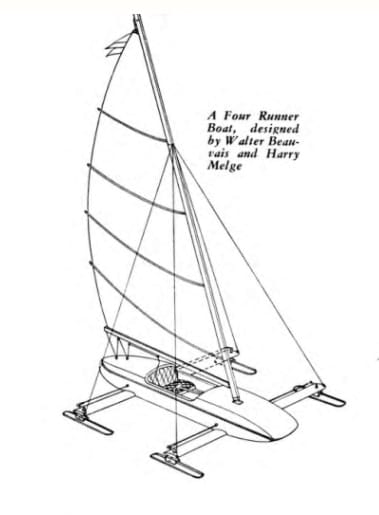by Deb Whitehorse | Nov 16, 2020 | 2020-2021, Home Page

Wings On The Ice
Some of the ice sailing community may be spending more time at home this winter than on the ice – depending upon local conditions. If sailing is impossible this season, let the internet help you explore more about the sport and its history in the form of online books. This is the first in a series of posts about ice sailing books.
I stumbled across a new-to-me resource, the HathiTrust digital library. What a surprise to find a complete digital version of Frederic Gardiner’s Wings On The Ice. Published in 1938, Wings On The Ice has been one of the most sought after ice-sailing books in North America for many years. My copy was an eBay purchase that cost the equivalent of a gallon of epoxy and hardener.
 I learn something new or relearn something forgotten each time I open Wings On The Ice. For instance, Harry Melges Sr. is listed along with Walter Beauvais -Beauvais is credited with originating the Skeeter class – as a designer of the Four Runner Iceboat. (See Iceboating Tech That Never Caught On.)
I learn something new or relearn something forgotten each time I open Wings On The Ice. For instance, Harry Melges Sr. is listed along with Walter Beauvais -Beauvais is credited with originating the Skeeter class – as a designer of the Four Runner Iceboat. (See Iceboating Tech That Never Caught On.)
Wings On The Ice is loaded with such a great wealth of information that I could devote a whole year of website posts to it. Speaking of relearning things forgotten, the book also references some of the earliest plans for ice yachts from Fredrik Henrik af Chapman’s book, ArchitecturNavalis Mercatoria published in 1768. (See Chapman’s Iceboat Plans of 1768.)
If ice sailing building, racing, and history interest you, pull up a chair to the virtual fire, turn on the e-reader, and immerse yourself in the details of this sport.
Like this:
Like Loading...
by Deb Whitehorse | Oct 25, 2017 | 2017-2018, Home Page

“Others quickly picked up the bow-steering design, and a few large bow-steerers were built…A Class B boat (250 square feet of sail) was built by Starke Meyer of Milwaukee and he ran away from everything else on the lakes”. Photo from the Carl Bernard Scrapbook Collection.
While researching last week’s Throw Back Thursday Gar Wood regatta post, I discovered a book that wasn’t on my radar or in my library, Meade Gougeon’s “Evolution of Modern Sailboat Design” written with co-author Ty Knoy. The stern-steerer iceboat on the cover hinted this was not a typical book about soft water sailboats with an obligatory paragraph about iceboats. Meade masterfully combined the story of iceboat design, mechanics, and history as he explained why some boats are faster than others. If you collect books about iceboating, this is an essential volume and available on Amazon.
Meade’s Bigger Picture Thinking:
- “Many of the refinements in sails and rigging that have been developed since World War I originated on iceboats.”
- “The first bow-steerer of any importance was built in 1931 by the Joy brothers, sailmakers in Milwaukee.” …”the Joy brothers and Walter Beauvais (of Williams Bay, WI) who came up with the machine (BEAU SKEETER) that retired the big boats forever…It went on the ice in Lake Geneva in 1933 and was an instant success.”
- Iceboaters were quick to take up the idea’s of Dr. Manfred Curry, a German sailor who came up with the idea of planing full length battens to curve into an airfoil. (An idea banned in most soft-water racing classes at the time of the book’s publication.) Iceboaters in the 1930s were using revolutionary ideas like rotating masts, wing masts, and full length battens while soft-water classes were outlawing advancements. The few softwater classes that allowed rotating masts (in 1976) were Midwestern scows, from the same part of the world where a good many iceboaters are also scow sailors in the summer.
- The aviator, Charles Lindbergh, (who spent a semester here the university in Madison and motored around Lake Mendota on an ice sled) “is said to have had a hand in the design of a very advanced rig” that was put on the Class A stern-steerer, DEUCE II, which was owned by Lindbergh’s cousin, Joseph Lodge of Detroit.

“On DEUCE II, with the help of Lindbergh, Lodge installed a rotating wing mast, believed to be the first ever used…DEUCE II was a hard luck boat, plagued by rigging failures, as Lodge challenged for the Stuart Cup and the Hearst International trophies in the 1930s.” Photo from the Carl Bernard Scrapbook Collection.

“Most of the troubles [from DEUCE II] were ironed out in DEUCE III, a remodeled version of DEUCE II, and in 1938, Lodge won both trophies to become champion of the world for Class A.” Photo from the Carl Bernard Scrapbook Collection.
Like this:
Like Loading...
 I learn something new or relearn something forgotten each time I open Wings On The Ice. For instance, Harry Melges Sr. is listed along with Walter Beauvais -Beauvais is credited with originating the Skeeter class – as a designer of the Four Runner Iceboat. (See Iceboating Tech That Never Caught On.)
I learn something new or relearn something forgotten each time I open Wings On The Ice. For instance, Harry Melges Sr. is listed along with Walter Beauvais -Beauvais is credited with originating the Skeeter class – as a designer of the Four Runner Iceboat. (See Iceboating Tech That Never Caught On.)





